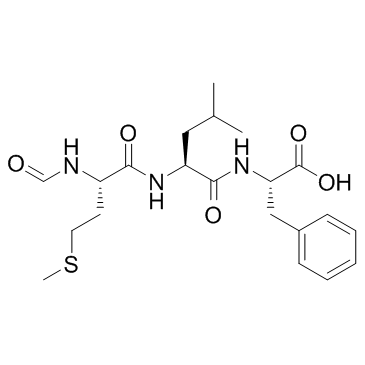| Cas No.: | 59880-97-6 |
| Chemical Name: | N-Formyl-methionyl-leucyl-phenylalanine |
| Synonyms: | L-Phenylalanine,N-formyl-L-methionyl-L-leucyl-;N-Formyl-L-methionyl-L-leucyl-L-phenylalanine;N-Formyl-Met-Leu-Phe;fMLF, fMLP;fMLP(N-Formyl-Met-Leu-Phe);For-Met-Leu-Phe-OH;formyl-Met-Leu-Phe;Formyl-Met-Leu-Phe-OH;fMLP;formyl-MLF;N?formyl?L?methionyl?L?leucyl?L?phenylalaninol;N-formyl-L-methyonyl-L-leucyl-L-phenylalanine;N-Formyl-MLF;TYRAMINE HYDROCHLORIDE;Chemotactic peptide;fMLF;fMLP (misnomer but widely used);N-Formyl-Met-Leu-Phe-OH;NSC 350593;F-Met-leu-phe;fMetLeuPhe;N-Formyl-methionyl-leucyl-phenylalanine;N-FORMYLMETHIONINE LEUCYL-PHENYLALANINE;(S)-2-((S)-2-((S)-2-Formamido-4-(methylthio)butanamido)-4-methylpentanamido)-3-phenylpropanoic acid;fMet-Leu-Phe;(2S)-2-[[(2S)-2-[[(2S)-2-formamido-4-methylsulfanylbutanoyl]amino]-4-methylpentanoyl]amino]-3-phenylprop |
| SMILES: | S(C([H])([H])[H])C([H])([H])C([H])([H])[C@@]([H])(C(N([H])[C@]([H])(C(N([H])[C@]([H])(C(=O)O[H])C([H])([H])C1C([H])=C([H])C([H])=C([H])C=1[H])=O)C([H])([H])C([H])(C([H])([H])[H])C([H])([H])[H])=O)N([H])C([H])=O |
| Formula: | C21H31N3O5S |
| M.Wt: | 437.5529 |
| Purity: | >98% |
| Sotrage: | 2 years -20°C Powder, 2 weeks 4°C in DMSO, 6 months -80°C in DMSO |
| Description: | N-Formyl-Met-Leu-Phe, also known as fMLF, is a potent neutrophil chemoattractant and the reference agonist for the G protein-coupled N-formylpeptide receptor (FPR). |
| Target: | TNF-alpha[1] |
| In Vivo: | N-Formyl-Met-Leu-Phe promotes bone formation in zebrafish and rabbits. Extensive skeletal development is evident at 5 dpf in over 80% of N-Formyl-Met-Leu-Phe-treated zebrafish. Treatment with N-Formyl-Met-Leu-Phe results in increased expression of Runx2. Bone marrow spaces are widely formed, and connective tissue covering bone is dense, like periosteum, in N-Formyl-Met-Leu-Phe-treated calvaria[1]. N-Formyl-Met-Leu-Phe mediate release of calprotectin from PMN in vitro. It induces release of calprotectin from PMN in a dose dependent manner. A minimum of 10% of total PMN calprotectin is retained at concentrations of 0.1-10.0 nM of N-Formyl-Met-Leu-Phe[3]. |
| In Vitro: | Binding of N-Formyl-Met-Leu-Phe to its specific cell surface receptor, N-formyl peptide receptor (FPR), triggers different cascades of biochemical events, eventually leading to cellular activation. FPR is a chemoattractant receptor belonging to the G protein-coupled receptor family. N-Formyl-Met-Leu-Phe promotes osteoblastic commitment and suppresses adipogenic commitment under osteoblastic differentiation conditions. N-Formyl-Met-Leu-Phe stimulates osteogenesis is associated with increased expression of osteogenic markers and mineralization. N-Formyl-Met-Leu-Phe inhibits expression of peroxisome proliferator-activated receptor-γ1. N-Formyl-Met-Leu-Phe-stimulated osteogenic differentiation is mediated via FPR1-phospholipase C/phospholipase D-Ca2+-calmodulin-dependent kinase II-ERK-CREB signaling pathways[1]. N-Formyl-Met-Leu-Phe, a bacterial-derived peptide, induced proinflammatory cytokine gene expression in human peripheral blood monocytes. Bacterial products LPS and N-Formyl-Met-Leu-Phe synergistically induce inflammatory response via multiple signaling pathways. TLR4, IKKβ-IκBα, and NF-κB signaling pathways are involved in the synergistic induction of TNF-α via p65 nuclear translocation-dependent mechanisms[2]. |
| Cell Assay: | Cells are cotransfected with either a dominant negative form of IκBα or a dominant negative form of IKKβ together with the NF-κB-dependent luciferase reporter plasmid. The plasmid pCMVβ is used as a control for transfection efficiency and this is monitored via the expression of β-galactosidase. Cells are transiently transfected with plasmids using DEAE-dextran. The transfected cells are cultivated for 48 h before a 6-h incubation in medium ±N-Formyl-Met-Leu-Phe, LPS, or N-Formyl-Met-Leu-Phe/LPS. Luciferase activity is determined by using the luciferase assay kit and a Monolight 3010 luminometer[2]. |
| Animal Administration: | Mice: N-Formyl-Met-Leu-Phe is prepared in sterile PBS. Under the anesthesia, mice are intranasally treated with LPS (0.3 mg/kg) or N-Formyl-Met-Leu-Phe (0.5 mg/kg) or N-Formyl-Met-Leu-Phe and LPS in 50 μL of sterile PBS (control), BAL is performed by cannulating the trachea with sterilized PBS, and cells from BAL fluid are stained with Wright-Giemsa stain after cytocentrifuge. For TNF-α protein release, BAL fluid is collected and secreted TNF-α is measured by ELISA as described above[2]. |
| References: | [1]. Shin MK, et al. N-formyl-methionyl-leucyl-phenylalanine (fMLP) promotes osteoblast differentiation via the N-formyl peptide receptor 1-mediated signaling pathway in human mesenchymal stem cells from bone marrow. J Biol Chem. 2011 May 13;286(19):17133-43. [2]. Chen LY, et al. Synergistic induction of inflammation by bacterial products lipopolysaccharide and fMLP: an important microbial pathogenic mechanism. J Immunol. 2009 Feb 15;182(4):2518-24. [3]. Hetland G, et al. Chemotaxins C5a and fMLP induce release of calprotectin (leucocyte L1 protein) from polymorphonuclear cells in vitro. Mol Pathol. 1998 Jun;51(3):143-8. |

 To enhance service speed and avoid tariff delays, we've opened a US warehouse. All US orders ship directly from our US facility.
To enhance service speed and avoid tariff delays, we've opened a US warehouse. All US orders ship directly from our US facility.




















